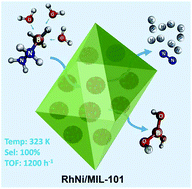Metal–organic framework immobilized RhNi alloy nanoparticles for complete H2 evolution from hydrazine borane and hydrous hydrazine†
Abstract
Metal–organic framework (MOF) immobilized Rh–Ni alloy nanoparticles (NPs) with a mean size of 2.8 nm have been facilely and successfully fabricated via a reduction rate controlled method. Bimetallic NP/MOF composites with uniform tiny RhNi alloy NPs immobilized on MOFs, high surface areas (1970 m2 g−1), and accessible porous structure have been obtained. The resulting RhNi/MOF catalysts show high catalytic activity and robust durability for complete H2 evolution from hydrazine borane (N2H4BH3) and hydrous hydrazine (N2H4·H2O). The optimized Rh0.8Ni0.2/MIL-101 catalyst exhibits excellent catalytic performance for the dehydrogenation of N2H4BH3 and N2H4·H2O in aqueous solution with 100% conversion and hydrogen selectivity, high total turnover frequencies (TOF), up to 1200 and 428.6 mol(H2) mol(Rh+Ni)−1 h−1, respectively, the highest over Rh-based catalysts. The high activity and prominent durability of Rh0.8Ni0.2/MIL-101 are highly dependent on the features of the MOF immobilized tiny RhNi alloy NPs, the strong interaction between the MOF crystal and RhNi alloy NPs, the optimized surface and electronic structure of RhNi alloy with an atomic ratio of 8 : 2, and the accessible open porous structure for free mass transfer.



 Please wait while we load your content...
Please wait while we load your content...